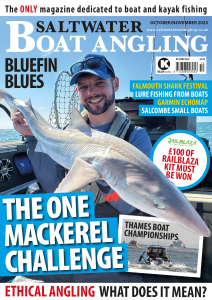Kyle Waterhouse goes on another wild angling adventure, this time on the other side of the world!
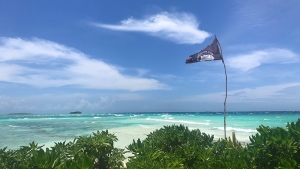
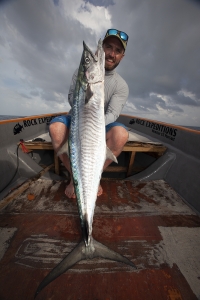
Following a couple of trips to Panama’s beautiful wild coast it was safe to say I’d caught the bug for overseas angling adventures. I’ve begun to really crave the experience and find each trip away really changes my outlook on fishing. I love how travel broadens your angling mindset and I always return with new ideas and a thirst for more.
Off the grid, hunting new species
So, when it was time for a new adventure I was looking to test myself on some entirely new species. Though the fishing is obviously the most important element when planning a new trip, it’s also crucial to find the right type of experience you’re looking for. Personally, I’m not overly excited by the more well-known fishing holiday operators. A lot of emphasis is placed on luxury, technology and comfort, whereas I’m simply looking for remoteness and that feeling of isolation and being off grid.
You’re not going to find that at a resort crammed with boats and other anglers. I was seeking more of an expedition. The feeling of being the first angler to cast a lure somewhere is just impossible to beat and there aren’t many places left that can offer you that.
Papua New Guinea
….is a destination shrouded in mystery and not just for its fishing. The country has a rich and diverse culture and an exceptional mixed ecosystem of rainforests, highlands, tropical coral reefs and islands. For UK anglers, it’s still an unusual option for sport fishing as there are only a handful of operations running there. Each outfitter has its own selling points but it was Rock Expeditions, run by Luke Wyrsta, that caught my attention. They have been operating in PNG since 2013 and run a unique expedition into the most remote part of the Louisiade Archipelago.
Lying north east of Australia, where the Coral sea meets the Solomon sea, the far east frontier reefs are located over 250 km from the mainland. For us to even fish this far out has involved significant planning and logistics. Luke has established a team of locals and between them they have constructed an island base camp near Misima island. It’s in a strategic position and offers the most wild and inaccessible fishing grounds anywhere in Papua New Guinea.
Clear water, stunning reefs and strong currents
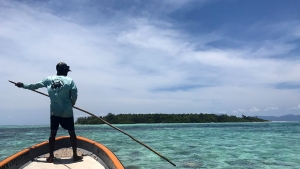
The environment is characterised by strings of stunning tropical islands that are fringed by bustling coral reefs and remarkably clear water. In this uncharted area you’ll find everything from shallow flats and coral edges, to seamounts and ledges that plummet off into the abyss. Everywhere you look there is wildlife and the reefs are alive with abundant marine and bird life. The weather can often be unpredictable with squalls being quite frequent. The currents in that part of the world are some of the strongest imaginable so it’s a full-on place and not to be taken lightly.
It’s nothing short of a fishing paradise and Luke’s team of locals know this ground and its wild currents intimately.
Trevally and dogtooth
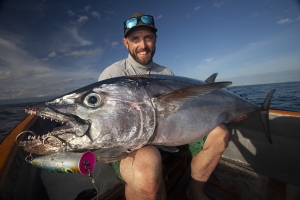
The fishing is done from panga boats which are fitted with Yamaha outboards and with just two anglers per boat means there’s plenty of space for each person to do their thing. The fishing is primarily targeted at giant trevally and dogtooth tuna which are the alpha species found on these reefs. Sight casting with heavy topwater lures and speed jigging are done to target these powerful fish which can grow to their maximum sizes there. These fish can be found almost anywhere on the day, but efforts are usually focused around the steep drop offs and reef edges.
Aside from these main targets, there’s a whole host of other game fish that can be found here including spanish mackerel, coral trout, barracuda and giant Napoleon wrasse. I don’t think many places can match such an exciting array of sport fish and for me, almost every catch would be a new species too…does it get any better?
Luke and his team
I was travelling solo from the UK and after a couple of buffer days in the Port Moresby, the capital of Papua New Guniea, I flew to Misima island where I was met by Luke and his team. At 35 years old Luke is just a couple years older than me. He calls Australia home but spends most of his time guiding in PNG, Indonesia and Kanton island, to name just a few places. He’s a well-travelled, avid GT angler and is very well regarded in that quite niche circle.
After over a year of talks and anticipation it was great to finally meet him. What he’s achieved for his age is very impressive and he’s certainly got a pioneering vision of how he wants to live life. He had a strong rapport with his team, and they consisted of around a dozen local guys who all held various jobs – from skippering and navigation, to cooking and general camp maintenance. There were plenty of people involved and the whole ethos of the operation was based on sustainability and creating a minimal footprint on this pristine environment.
Tackle
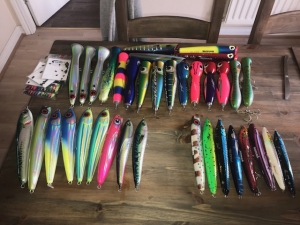
Since Misima was the start point for our expedition the next step was to get our mountain of fishing gear loaded onto the panga so we could make a 2-hour boat journey to our tiny island base camp. For this expedition we’d be supplying all our own fishing tackle. I’d brought plenty of heavy jigging and popping rods from our Penn range, including some new prototype overseas rods that are in development. A ton of jigs, poppers and stickbaits made up the bulk of our weight allowance, though we all knew we’d not be returning with them all!
Bushy Island and the camp
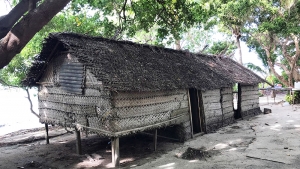
Our basecamp was aptly named ‘Bushy island’ and was around 35 km offshore and with the strong wind we had that day it was clearly going to be a wet ride. I’m always impressed with how well the flat hulled panga boats handle rough seas and once safely on Bushy island it was time to unpack, rig up and settle into our new surroundings.
It was a beautiful island and dense with palm trees which I’m guessing is what gave it its name. We were of course the only anglers there and all around us were shallow coral reefs which glistened in different shades of blue and turquoise. We were now so far from any civilisation that there was no phone signal, no wi-fi and no electricity. It was a perfect haven and Luke had planned for us to get out fishing right away. Unfortunately, the weather had other ideas and the wind increased so much that we had to secure camp as it threatened to blow our tents away! The crew did some emergency weaving of palm leaves which created surprisingly effective wind guards! We were just thankful we’d got to the island when we had as the sea was looking rather gnarly before sundown.
The camp itself was basic though fully functional and had all we needed to fish and survive in relative comfort. The sleeping quarters were made up of 3 tents, each including a mattress and insect net. The main communal area was a tarp dressed over a big wooden frame and some benches for seating. Another couple of tarps provided a floor and cover to protect our gear. There was a rod rack made from sticks and there were a few other huts used by the locals for either cooking, smoking fish or sleeping. Boats were moored in the shallows right by camp and the shower facilities consisted of a bag hung from a tree!
Power was available and came via a petrol generator for essential charging of the safety equipment. Safety was taken seriously, Luke had several Garmin in-reach mini satellite messengers for the crew, and a satellite phone for emergencies. Other electronics like fish finders and cameras would also need charging and I was amazed to also find a chest freezer in one of the huts. This was by far the most luxurious novelty item to be discovered at the base camp… you just can’t beat a cold beer in thirty degrees!
Now to the fishing
The fishing began the following morning and miraculously the wind had died right off. The daily routine would be to wake at 5:30, have a quick breakfast, and then we would then be off in search of fish. That morning was a mix of excitement and nervousness for me. I’d never caught a GT and they have a formidable reputation that’s hard to ignore. Everything needs to be perfect, from your gear and knots to your popping and striking techniques and that’s before you even hook one! Poppers were heavy and at over 200 grams a piece they were very hard work. They’d be attached to 200 lb mono leaders and 110 lb braid. Everything was beefed right up for this trip and I’d spent weeks perfecting my knots and was now ready to test them.
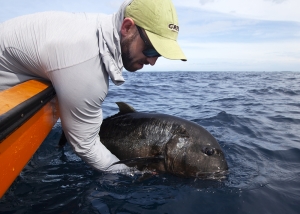
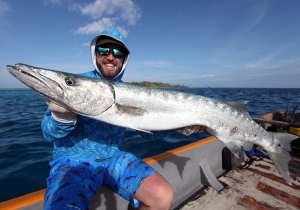
Luke looked over our gear and locked our drags down so tight that you couldn’t physically pull braid off by hand. Surely, he’d put us on a few small fish to warm up I thought. How wrong I was? We were mid-way through the first day when all hell broke loose as a huge fish charged down my popper. The massive lure was engulfed in a ridiculous explosion and the power of the strike nearly pulled me right over the rails!
Setting the hook
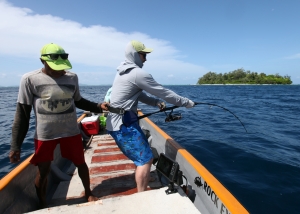
It’s important to set the hooks after a GT hits and if you’re not used to this then it doesn’t really come naturally to begin with. Luke’s chants of ‘set it, set it’ are still ringing in my ears now and after a few big strikes the fish was hooked and the fight really began. This was clearly a decent fish and it stripped braid off my locked drag with total ease. Captain Ebi gunned the boat into deeper water, almost knocking me off balance as I held on for dear life. Once away from the jagged reef edge an awkward dogged battle began as the fish stayed down determined to reef me. The whole thing was brutal, but brilliant at the same time and fifteen minutes later I was cheering as it hit the surface.
Luke tailed the fish onto the deck and holy cow what a fish it was. For my first GT I couldn’t have asked for a meaner looking specimen. It was completely jet black and so fired up that all its fins were flared out aggressively as the crew kept it wet with buckets of water. It was around 25-30 kg and from what I gather the dark ones are quite sought-after and I can see why!
That day just continued to get better when I then hooked a monstrous coral trout of over 15 kg on the same popper. I’d seen a few photos of these big PNG trout and was always in awe with their beautiful spotted appearance. Mine was a real dinosaur and though they’re considered great eating there was no question of such a big specimen not being released. Catch and release would be the focus, though we’d need to find some fish to feed ourselves throughout the week and smaller trout and tuna would be on the menu.
Doggie ally
As if that day hadn’t been enough of an introduction, Luke then took us out to a spot he called Doggie ally which was very close to base camp. Here would become a favourite spot of ours over the week and we were warned to crank our drags up even tighter here as there had been some huge ones in the area recently. At this spot, strong currents are funnelled between two islands and there is a long reef ledge that drops off into deep, dark blue water. All along that ledge were shimmering baitfish schools, diving birds and the odd huge fish busting among it.
That evening, the strong current was pushing hard onto the shallow reef and seemingly pinning these poor bait fish tight to the wall. Luke was buzzing, he knew what was coming and the boat was quickly positioned up tide so we could make our casts towards the ledge from the deep water. Two pops in and BAM! We were both hooked up to Dogtooth Tuna as they made lightning fast runs back towards the wall. Their speed is terrifying, and the spool literally melts away in your hands as braid empties from it. There’s no stopping these fish and you just prey your braid doesn’t part before you sneak a look at what’s on the end!
That evening we caught and lost several dogtooth tuna, some of which were never going to be stopped. We ended the day on a massive high with fresh sushi, cold green cans and good banter. What a perfect days fishing and Luke called the day a level two PNG hattrick as I’d had a GT, coral trout and a dogtooth tuna, all in the same day. The level one was saved for swapping out the trout for holy grail…Napoleon wrasse.
Bad weather
Throughout the next seven days the weather was very up and down and caused us a headache trying to access some of the areas we wanted to fish. Despite the wind and frequent thunderstorms, the topwater fishing remained on fire. By working through my large lure selection, I was able to find lots of my target fish and bagged my first ever barracuda on day two. As a Pike angler back home, I was chuffed with that fish, a very cool predator and one I’d always wanted to catch.
Other highlights were aerial attacks from the resident narrow-barred spanish mackerel. They were abundant and provided plenty of entertainment during our stay as they’d launch themselves up to 30 ft into the air when striking at your lure. This happened many times and these razor toothed critters would manage to snip your lure off in the process. Thankfully we could occasionally drive the boat over and pick it back up off the surface. At other times, we weren’t so lucky and between the mackerel, dogtooth and sharks we went home quite a bit lighter.
Fifteen species
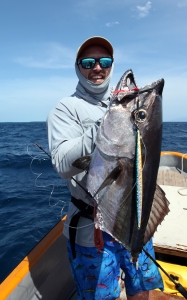
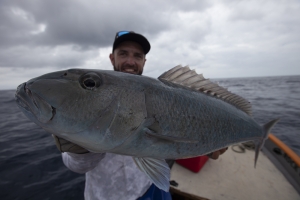
Topwater strikes from red bass, jobfish and sharks were very frequent and in fact one evening I landed six sharks in a row, all on the same popper, it was total madness! The variety of the fish species to be found in PNG is phenomenal and without trying I managed to find fifteen species in a week including a very rare footballer trout.
The icing on the cake came on day six when after losing several big doggies on both topwater and jig, I went on to finally land a true fish of a lifetime. Big dogtooth have a habit of either throwing the hooks, biting you off or simply annihilating you on the reef and you need a lot of fortune to land one.
Trying to bring them up once they’d hit a jig seemed almost impossible and I can only really describe what it’s like when they smashed you down deep as being attached to a falling elevator shaft! It’s insane how powerful they are with a bit of depth on their side. All the big fish we hooked whilst speed jigging seemed to bust us up, one way or another though we did land a few smaller ones. Landing a big one on topwater is equally as challenging though at least you have the benefit of applying heavy drag right from the surface… or so that’s the theory.
My big doggie slammed the lure right under the rod tip in a huge explosion which saw the whole fish breach out the water. It made a colossal dive for the bottom as soon as it was hooked and since we were quite shallow, I was just waiting for the braid to part. Somehow, I stayed connected and as I was right above it there wasn’t much angle for it to bust me off on the coral. I just applied as much pressure as possible without breaking anything and slowly got it under control. To add to the drama, my boat partner Paul was also playing a big GT at the same time so we couldn’t do a lot with the boat either. There was a moment where both fish were visible in the water next to each other, it was hairy and with our lines under so much pressure any touch and they’d have been gone.
The fish gods were shining and eventually both fish were landed. Luke’s always enthusiastic, though at that moment, he was buzzing just as much I was. It was the biggest Dogtooth any of his clients had ever landed on topwater and he put it at over 60 kg. With tired arms I could barely lift it; it was enormous, and at that size their teeth are just crazy. It was a new PB for me of any species and my trip was now made, nothing would have mattered from then on!
This expedition was about chasing a new experience where I could also learn new skills. This type of hardcore fishing really appeals to me and since I had done minimal topwater and virtually no speed jigging I was pleased to have an experienced guide on board showing me the ropes.
It is a long way to Papua New Guinea and the fishing is remote and physically exhausting, though I’d not have it any other way. Now I must think of something to match this experience, it’s getting harder every time, any ideas?
Papua New Guinea Travel advice
Getting there
• I flew with Philippine Airlines to Manila (13.5 hours) and transferred from there to Port Moresby (6.5 hours) From there a domestic flight with PNG Air took me to Misima island (2.5 hours)
• Baggage allowance – The international allowance was 30 kg and my rod tube travelled at no extra cost under sporting allowance. To avoid extra baggage fees with PNG air, travel within 24 hours of landing in Port Moresby and they’ll honour your international allowance. Also mention your tube contains dive equipment and golf clubs, that’ll help!
Other advice & practicalities
• Visas are usually issued on arrival, though due to Corona virus scares an online Visa approval was required before entry. This was checked on arrival and with the current travel situation a certain necessity. Do not travel without a visa.
• No vaccinations are required and there is not a big risk of malaria. In fact, in eight days I did not get bitten once by a mosquito. I would still suggest taking some DEET based spray just in case. The climate is very hot and humid, so pack plenty of F50+ cream, protective clothing and a small personal medical kit to treat blisters and cuts (you will get many)
• The local currency is Kina and is available from Port Moresby cash points on arrival. It’s advisable to have your local accommodation booked before you arrive and if catching an onward flight there are a few transit hotels offering free shuttle buses. I stayed in the Gateway Hotel and the Sanctuary resort; I’d recommend them both.
• Equipment – Heavy PE8-10 Popping and jigging rods, strong reliable Spinning Reels loaded with 80-110 lb braid & 200-300 lb mono leaders. Lures: Large Poppers & Stickbaits (100-250g) and Jigs (200-350g) with wire assists. A full kit list can be provided by Rock Expeditions upon enquiry. My advice is to get the lures on the list, all my best fish came to the lures that Luke recommended.
• Health and fitness – I would strongly recommend you prepare physically for this trip if you want to get the best out of it. It is extreme fishing and highly demanding. Strength and cardio training will go a long way.
Final Caution: Port Moresby is considered quite a dangerous place, do not go out at night and exercise the usual safe travel practices to eliminate opportunistic threats.
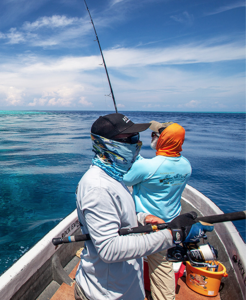
For more info contact
Luke Wyrsta: info@rockexpeditions.com
www.rockexpeditions.com
